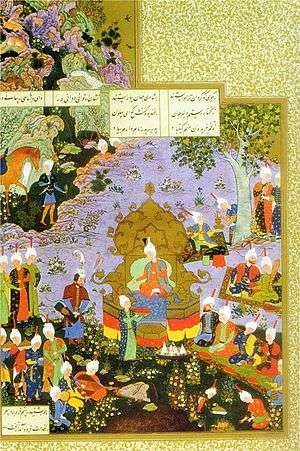Bijan and Manijeh
Bijan and Manijeh (also Bizhan and Manizheh, Persian بيژن و منيژه - Bīžan-o Manīža) is a love story in Ferdowsi's Shahnameh (Shāh-Nāmeh, The Epic of Kings). Bijan was the son of Giv, a famous Iranian knight during the reign of Kay Khosrow, the Shah of Iran, and Banu Goshasp, the heroine daughter of Rostam. Bijan falls in love with Manijeh, the daughter of Afrasiab, the king of Turan and the greatest enemy of Iran. The tale of his suffering and Manizheh constancy has been quoted by several others.
_Bizhan_Visiting_Manizha%3B_b)_Page_of_Calligraphy%2C_Two_Folios_from_a_Shahnama_(Book_of_Kings)_LACMA_M.81.12a-b_(1_of_2).jpg)
The tragedy of Bijan and Manije
People from Armenia complain to Kay Khosrow, the Shah of Iran,[1] that wild boars are invading their fields. Bijan fights the boars, forcing them back to their lairs. The day after, Gorgin, an Iranian knight who had accompanied Bijan on the quest, describes the beautiful gardens of Afrasiab to Bijan, tempting him to cross the border from Iran into the mythical land of Turan on the northern shores of the Caspian Sea. Turan is ruled over by the evil and egotistical King Afrasiab. In the garden, he meets Manijeh, Afrasiab's beautiful daughter. They fall madly in love; however, knowing her father's reaction to accepting an Iranian prince in her private chambers, Manijeh gives Bijan a sleeping potion and smuggles him into her house. He wakes, and Manijeh and her maids keep him hidden for many days. Eventually Afrasiab learns of Bijan and captures him.
Afrasiab sentences Manijeh into exile, so that both Bijan and Manijeh are forced to live out their days in the wilderness. Bijan also sends secret messages to Rostam, the Iranian hero charged with keeping the country safe from Afrasiab. Kai Khosrow, the Shah of Iran, looks into his Crystal Cup, and sees Bijan in the forest. Instead of launching a frontal invasion to find Bijan, the hero Rostam disguises himself as a merchant and, along with a few knights, enters Turan. When Manijeh hears that a wealthy merchant from Iran has arrived in Turan, she hopes that he was sent to find Bijan. They find Bijan and escape into Iran where there is much rejoicing at Bijan return to his homeland. Furious with his own daughter's treason, Afrasiab declares war on Iran. The Iranian and Turanian armies meet and a mighty battle ensues. The skies turn dark from the dust of the battlefield while trumpets and clashing cymbals signify the attack of the Iranian cavalry. Turan is defeated, and Afrasiab is forced to return home without his daughter and in shame.[2]
Family tree
| Kashvad | |||||||||||||||||||||||||||||||||||||
| Rostam | Goudarz | ||||||||||||||||||||||||||||||||||||
| Banu Goshasp | Giv | Afrasiab | |||||||||||||||||||||||||||||||||||
| Bizhan | Manizhe | ||||||||||||||||||||||||||||||||||||
References
- a title given to a King
- This story reflects the ongoing wars between the Iranian kings and two of their greatest enemies. "Turan" is a reference to the nomadic peoples of Central Asia (initially Persian-speaking), and the boar is a symbol of the Roman armies advanced into Armenia under the leadership of Mark Antony. The theme of doomed love stories between the youth of Iran and Turan is repeated several times in the Shahnameh (Book of Kings) and reaches its pinnacle in the epic of Siyâvash.
Sources
- Ferdowsi Shahnameh. From the Moscow version. Mohammed Publishing. ISBN 964-5566-35-5
- Bijan and Manijeh, by Hakim Abol-Qasem Ferdowsi Tousi, translated into English by Helen Zimmern (Iran Chamber Society).
- Shahnameh, by Hakim Abol-Qasem Ferdowsi Tusi, the complete work (64 Epics), in Persian (ParsTech). This work can be freely downloaded (File size, compiled in the form of an HTML Help File: 1.4 MB).
- A king's book of kings: the Shah-nameh of Shah Tahmasp, an exhibition catalog from The Metropolitan Museum of Art (fully available online as PDF), which contains material on Bijan and Manijeh


.png)
_of_Shah_Tahmasp_MET_DP107154.jpg)